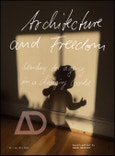In an attempt to find a way out of this crisis, there is growing debate about how architects might reassert the importance of their role and influence. On one side of this argument are those who believe that architects must refocus their attention on the internal demands of the discipline. On the other are those who argue that architects must, instead, reacquaint themselves with what many still believe to be the discipline’s core mission of advancing social progress and promoting the public good, and at the same time the scope of their traditional disciplinary remit.
At root, this question is fundamentally about freedom, about whether architects still possess it – if they have ever done – and whether it is possible to find the professional, disciplinary and individual autonomy to be able to define the spheres of their own practice. Presenting a variety of views and perspectives, this issue of AD takes us to the heart of what freedom means for architecture as it adapts and evolves in response to the changing contexts in which it is practised in the 21st century.
Contributors include: Phillip Bernstein, Peggy Deamer, Adam Nathaniel Furman, Kate Goodwin, Charles Holland, Anna Minton, Patrik Schumacher, Alex Scott-Whitby, Ines Weizman, and Sarah Wigglesworth.
Featured architects: Atelier Kite, ScottWhitbyStudio, C+S Architects, Anupama Kundoo, Noero Architects, Umbrellium, and Zaha Hadid Architects.
Architects are facing a crisis of agency. For decades, they have seen their traditional role diminish in scope as more and more of their responsibilities have been taken over by other disciplines within the building construction industry. Once upon a time, we might have seen the architect as the conductor of the orchestra; now he or she is but one cog in a vast and increasingly complex machine. In an attempt to find a way out of this crisis, there is growing debate about how architects might reassert the importance of their role and influence. On one side of this argument are those who believe that architects must refocus their attention on the internal demands of the discipline. On the other are those who argue that architects must, instead, reacquaint themselves with what many still believe to be the discipline’s core mission of advancing social progress and promoting the public good, and at the same time the scope of their traditional disciplinary remit. At root, this question is fundamentally about freedom, about whether architects still possess it – if they have ever done – and whether it is possible to find the professional, disciplinary and individual autonomy to be able to define the spheres of their own practice. Presenting a variety of views and perspectives, this issue of AD takes us to the heart of what freedom means for architecture as it adapts and evolves in response to the changing contexts in which it is practised in the 21st century. Contributors include: Phillip Bernstein, Peggy Deamer, Adam Nathaniel Furman, Kate Goodwin, Charles Holland, Anna Minton, Patrik Schumacher, Alex Scott-Whitby, Ines Weizman, and Sarah Wigglesworth. Featured architects: Atelier Kite, C+S Architects, Anupama Kundoo, Noero Architects, Umbrellium, and Zaha Hadid Architects.
Authors
Owen Hopkins is a writer, historian and curator of architecture. He is Architecture Programme Curator at the Royal Academy of Arts where he mounts series of events, lectures, discussions and exhibitions on architecture and related subjects. His writings feature widely in the architectural press.He is the author of Reading Architecture: A Visual Lexicon (Laurence King, 2012), Architectural Styles: A Visual Guide (Laurence King, 2014), From the Shadows: The Architecture and Afterlife of Nicholas Hawksmoor (Reaktion, 2015) and Mavericks: Breaking the Mould of British Architecture (Royal Academy Publications, 2016).








